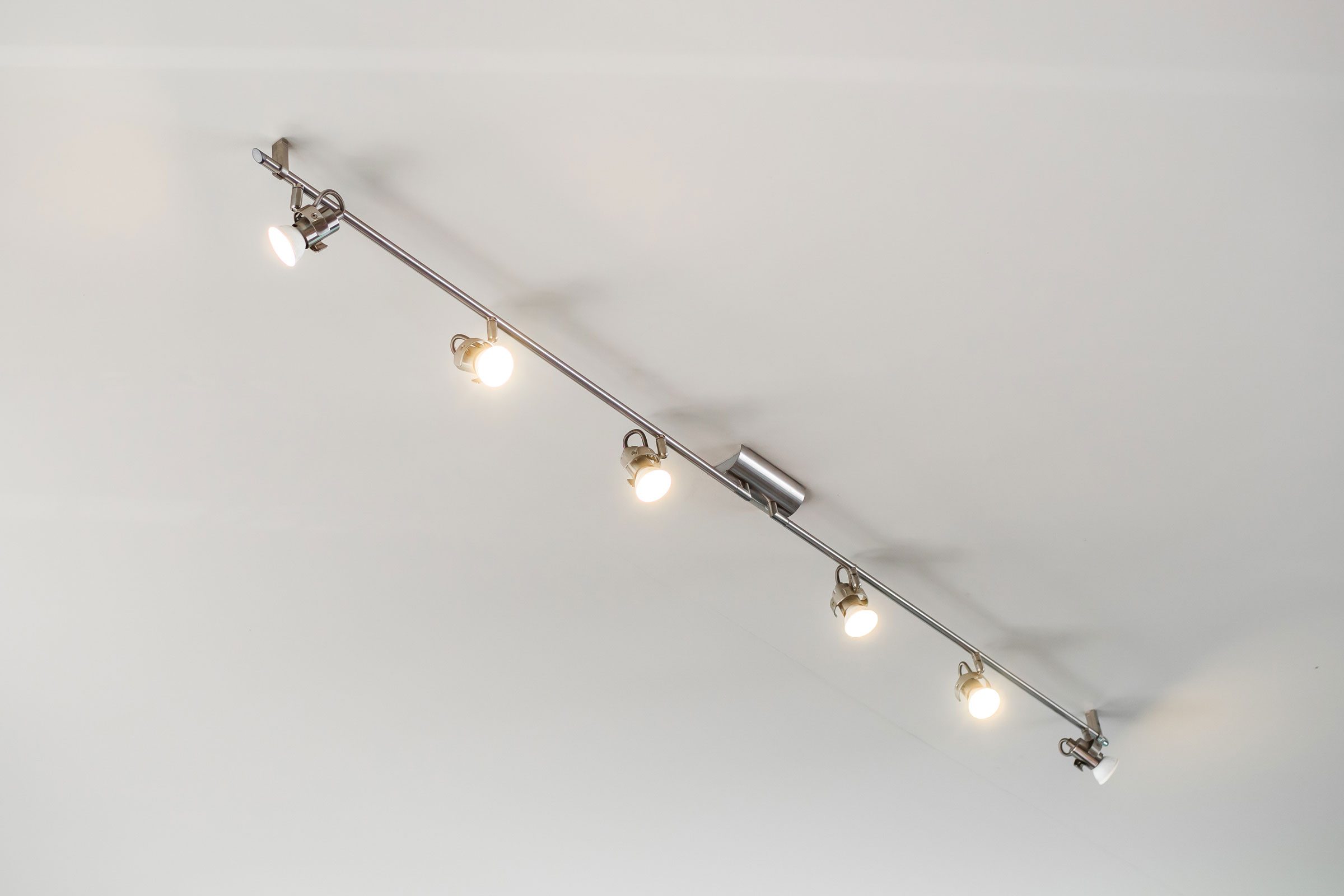If you think track lighting is an ugly strip of spotlights attached to the ceiling, think again! Here's what you need to know about track lighting.

Track Lighting Buyer’s Guide

Track lighting can be the answer for anyone who wants to highlight a favorite piece of art, stake out a cozy reading area or create a comfortable gathering place for friends and family. It’s also flexible — you can change it up to match décor updates. All this while being just slightly more difficult to install than a conventional light fixture.
On This Page
What Is Track Lighting?
Most people imagine track lighting as a series of individual lamps, called heads, that slide independently along a metal track. That’s accurate for certain systems. But there are others as well, and design variety is one reason to consider track lighting.
Typically, track lighting is hardwired and connected to a wall switch. Heads can be focused spotlights, radiant spotlights or pendants that provide more general room illumination.
Types of Track Lighting
Track lighting systems can be distinguished by the style of track. There are three basic types:
Fixed track
This system features a metal bar with permanently attached heads. Typically, the electrical terminal goes in the center of the bar that mounts into a standard ceiling box. Although the heads are fixed on the track, they usually swivel, and the entire track may also rotate. That makes it possible to adjust illumination.
Linear track
Linear or standard track lighting systems are the most well-known. These feature lengths of metal with rectangular cross sections, available in two- to eight-foot lengths. The heads snap into the tracks and connect with the electrical cable that runs inside.
Joel Worthington of Mr. Electric says three linear track systems exist: H-type, J-type and L-type. They’re named for Halo, Juno and Lightolier, the manufacturers who set the standards for each type. These systems are not interchangeable, and only one, H-type, has a dedicated grounding bus. The others, Worthington says, employ grounding channels built into the tracks.
Monorail track
Unlike linear track, which is attached to the ceiling, monorail tracks are suspended on bars called standoffs. The tracks are cylindrical and can be bent by as much as 30 degrees. Monorail tracks typically employ low-voltage power transformers because the heads, which can slide along the tracks, draw power from the exposed metal.
Pros and Cons of Track Lighting
Pros
- Flexibility: You can select heads based on your lighting needs, reposition them individually and add and subtract heads up to the capacity of the circuit.
- Ease of installation: Mounting a track lighting system is a straightforward job similar to mounting a conventional light fixture.
- Low cost: Installation costs are comparable to most other ceiling- and wall-mount fixtures and decidedly cheaper than recessed lighting. More on costs below.
Cons
- Head space: Track lighting doesn’t work well in rooms with low ceilings.
- Style-specific: The contemporary flair track lighting offers doesn’t fit in every setting, particularly one with a traditional or historic motif.
- Area-specific: Track lighting heads don’t provide much general room illumination and usually need to be supplemented by other lights.
What To Consider When Buying Track Lighting
As you consider the best track lighting system for your home, keep these points in mind:
- Track lighting heads can operate at line voltage (120 volts) or draw power from a 12- or 24-volt transformer wired into the home’s electrical system. Low-voltage heads usually don’t provide as much light as line voltage heads and are better for mood lighting.
- Some systems accept pendants, which provide some general illumination, as well as bullet heads, akin to mini-spotlights. You might opt for pendants if you need more light. Just remember they hang down from the ceiling, so they need to go in low-traffic areas like over a countertop or table, or along a wall.
- While it doesn’t matter whether you choose H-, J-, or L-type tracks, make sure the heads and pendants you want are available for the type of track you choose. You can’t mix and match different types.
Track Lighting Installation
Track lighting must be secured to the ceiling. You can do this by driving screws into ceiling joists or into drywall anchors, such as molly bolts, that can support the weight of the heads and/or pendants.
The electrical terminal, which may include a low-voltage transformer, mounts on a conventional ceiling electrical box. The wiring is the same as it is for any other light fixture.
Some tracks incorporate two hot wires so you can turn some of the lights on and off independently. If you’re installing one of these, you’ll need to connect to separate circuits in the ceiling box, each controlled by its own switch.
Track Lighting Costs
An entire track lighting kit, including track and three to five heads, costs $60 to $150. If you need more heads, each will cost from $12 to $50, depending on the style.
Though you could DIY the installation and save money, Worthington suggests hiring a pro. That way you can be sure the tracks are secured properly and the lights operate as intended. Installation of a basic track and heads is a two- to three-hour job that could run you from $150 to $300, depending on where it’s going and who you hire.
If you need a ceiling box and switch installed, you’ll probably need an electrician to add them. That will cost from $150 to $900, depending on the complexity of the job.




















